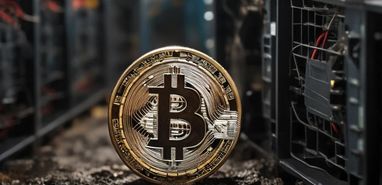
Hypothetically, mining 1 Bitcoin could take around 10 minutes. This is because a new block is added to the Bitcoin blockchain, releasing the associated block reward, approximately every 10 minutes. However, in reality, mining 1 Bitcoin in a reasonable timeframe requires a substantial investment in ASIC miners.
Currently, the Bitcoin block reward stands at 3.25 BTC. If you were to set up a solo Bitcoin mining operation and got incredibly lucky, you could earn 3.25 BTC within 10 minutes of starting. But it’s crucial to understand that this scenario is highly improbable without a significant investment in Bitcoin mining hardware.
Given the intense competition in Bitcoin mining and the protocol’s rule that 100% of the block reward goes to a single miner, most miners would never earn any BTC without joining a mining pool.
When a miner within a pool receives a block reward, the reward is distributed among all miners in the pool based on their contributed hashrate. For example, if you contribute 10% of the pool’s hashrate and another miner in your pool finds a block, you would receive 10% of the 3.125 BTC reward (0.3125 BTC).
Realistic Timeframe to Mine 1 Bitcoin
The Bitcoin blockchain’s transparency allows us to access all the necessary information to estimate the time required to mine 1 Bitcoin under various conditions.
By analyzing a mining pool’s average hashrate over a specific period and the number of blocks mined during that time, we can approximate the required hashrate to mine 1 BTC within that period.
For example, let’s calculate the hashrate needed to mine 1 BTC in a day.
Foundry, the largest Bitcoin mining pool in the world, mined 306 blocks in the last 7 days, translating to 956 BTC in rewards. By dividing this by 7, we find that they earned approximately 136.6 BTC per day.
Thus, to mine 1 BTC per day on average, you would need 1/136.6 (or about 0.7%) of Foundry’s hashrate. Foundry’s average hashrate over the last 7 days was 187.9 EH/s, so 0.7% of this is 1.31 EH/s. This is the hashrate required to mine 1 BTC per day on average.
Achieving this level of hashrate requires a significant investment. For instance, let’s consider the Bitmain Antminer S21 ASIC miner, which produces 200 TH/s and is priced at $5,400 by the manufacturer.
To reach the 1.31 EH/s currently needed to mine 1 BTC in a day, you would need 6,550 Antminer S21 miners, costing about $35 million.
Your Computing Power Determines the Time to Mine 1 Bitcoin
Now, let’s examine a table to understand how quickly you can mine Bitcoin based on different investment levels in ASIC miners:
| Number of Bitmain Antminer S21 ASIC miners | Hashrate | Investment amount | Time to mine 1 Bitcoin |
|---|---|---|---|
| 5 | 1,000 TH/s | $27,000 | 1,310 days |
| 10 | 2,000 TH/s | $54,000 | 655 days |
| 50 | 10,000 TH/s | $270,000 | 131 days |
| 100 | 20,000 TH/s | $540,000 | 65 days |
| 500 | 100,000 TH/s | $2.7 million | 13 days |
| 1,000 | 200,000 TH/s | $5.4 million | 6.5 days |
| 5,000 | 1 EH/s | $27 million | 1.3 days |
| 10,000 | 2 EH/s | $54 million | 0.65 days |
These calculations are based on the difficulty of mining Bitcoin as of May 15, 2024, assuming the use of Antminer S21, which produces 200 TH/s and costs $5,400.
It’s also essential to consider other Bitcoin mining costs, such as electricity, maintenance, cooling, and space. These expenses would significantly increase the investment required to mine 1 BTC within a specific period.
Increasing Competition Post-Bitcoin Halving
The Bitcoin mining landscape has become increasingly competitive following the Bitcoin halving on April 19, 2024. This halving reduced the block reward from 6.25 BTC to 3.125 BTC.
Despite a recent drop in Bitcoin mining difficulty, it remains near the levels seen in March. This means that mining a Bitcoin block still requires about the same resources as in March, but now yields half the rewards, putting pressure on less efficient mining operations.
Why Bitcoin Miners Join Mining Pools
Without specialized Bitcoin mining hardware, mining 1 Bitcoin in any reasonable timeframe is nearly impossible. For example, using a standard gaming GPU for Bitcoin mining won’t work due to the high level of competition.
Solo mining (mining Bitcoin without joining a mining pool) is more like gambling in a lottery than a reliable income source unless you operate a large-scale mining farm with hundreds or thousands of rigs. The most feasible way to earn through Bitcoin mining is by joining a mining pool, which still requires a significant investment in proper mining hardware to make sense financially.
The reason it’s challenging to profit from solo mining is that the Bitcoin protocol awards each block reward to only one miner. For example, if you control just 0.0001% of the total Bitcoin network’s hashrate, you would have only a 0.0001% chance of receiving a reward as each block is added to the Bitcoin blockchain.
Joining a mining pool provides a more predictable revenue stream. When any miner in your pool successfully mines a block, you receive a portion of the Bitcoin reward proportional to your contributed hashrate.
Cost of Electricity and Maintenance
When considering Bitcoin mining, it is crucial to account for the costs of electricity and maintenance. Electricity costs can significantly impact the profitability of mining operations. Mining equipment consumes a substantial amount of electricity, and the cost per kilowatt-hour (kWh) varies by location. Efficient cooling systems are also necessary to prevent overheating of mining rigs, adding another layer of expense.
For example, mining in regions with low electricity costs, such as certain areas in China, Canada, and Iceland, can be more profitable compared to regions with higher electricity costs. Additionally, maintenance costs, including replacing worn-out parts and ensuring the optimal performance of mining rigs, contribute to the overall expenses.
Environmental Impact of Bitcoin Mining
Bitcoin mining has faced criticism for its environmental impact. The significant energy consumption required for mining operations contributes to carbon emissions and environmental degradation. As the demand for Bitcoin increases, so does the energy required to mine new blocks. This has led to calls for more sustainable and eco-friendly mining practices.
Several initiatives aim to address the environmental concerns associated with Bitcoin mining. Some mining operations are exploring the use of renewable energy sources, such as solar, wind, and hydroelectric power, to reduce their carbon footprint. Additionally, innovations in energy-efficient mining hardware and practices are being developed to mitigate the environmental impact.
Advances in Mining Hardware
Advancements in mining hardware have significantly impacted the efficiency and profitability of Bitcoin mining. ASIC miners, specifically designed for Bitcoin mining, have replaced general-purpose hardware like CPUs and GPUs due to their superior performance and energy efficiency.
The development of new generations of ASIC miners continues to push the boundaries of mining efficiency. For example, the Bitmain Antminer S21 offers a substantial increase in hashrate compared to previous models, allowing miners to achieve higher levels of productivity. As technology evolves, mining hardware manufacturers strive to create more powerful and energy-efficient devices.
The Role of Cloud Mining
Cloud mining has emerged as an alternative to traditional mining setups. With cloud mining, individuals can rent mining hardware and computing power from remote data centers. This eliminates the need for purchasing and maintaining physical mining equipment.
Cloud mining offers several advantages, including reduced upfront costs, elimination of maintenance responsibilities, and access to professional mining facilities. However, it is essential to research and choose reputable cloud mining providers to avoid potential scams and ensure a reliable mining experience.
The Future of Bitcoin Mining
The future of Bitcoin mining is likely to be influenced by technological advancements, regulatory developments, and environmental considerations. As the Bitcoin network continues to grow, mining difficulty is expected to increase, making it more challenging for individual miners to compete.
Regulatory frameworks may also impact the mining industry. Governments around the world are exploring regulations to address concerns related to energy consumption, financial stability, and the environmental impact of mining activities. Miners will need to adapt to evolving regulations and ensure compliance to continue their operations.
Furthermore, the development of sustainable mining practices and the adoption of renewable energy sources will play a crucial role in shaping the future of Bitcoin mining. As the industry seeks to balance profitability with environmental responsibility, innovative solutions and collaborations will be essential.
Conclusion
With Bitcoin priced above $60,000 at the time of writing, it’s no surprise that mining 1 Bitcoin is a formidable task.
The recent Bitcoin halving has intensified competition in the mining industry, making it viable only for miners who can achieve high efficiency through low electricity costs, effective cooling solutions, or other competitive advantages.
Without significant investment in money and time, Bitcoin mining will likely result in a financial loss. However, if you want to mine Bitcoin as a hobby, the financial aspect becomes less critical.








By Andrej Kovacevic
Updated on 18th July 2024